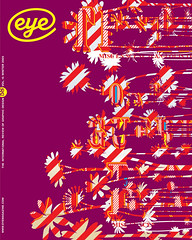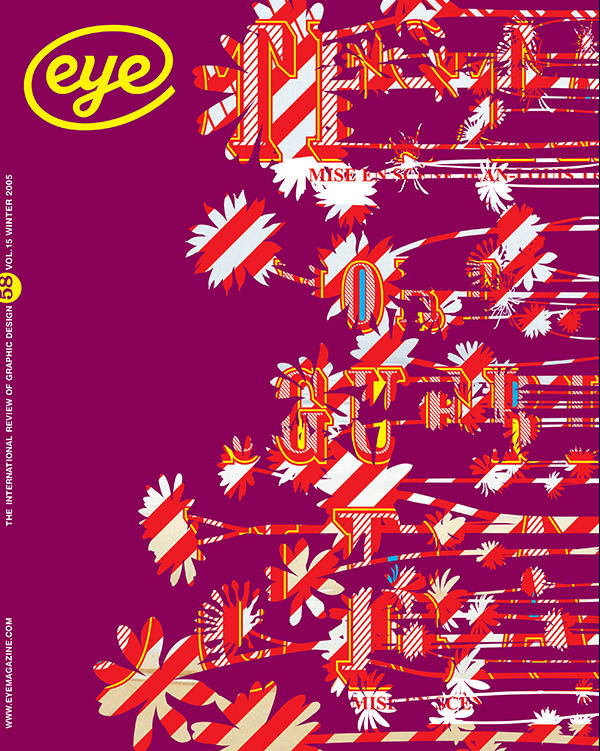Winter 2005
Hands-on design and digital angst at the AIGA
the editor
various designers
Stefan Sagmeister
Milton Glaser
R. Sikoryak
Christoph Niemann
Nicholas Blechman
Chaz Maviyane-Davies
Scott Stowell
Ellen Lupton
Grapus
AIGA ‘Design’ Conference
Boston, Massachusetts<br>15-18 September 2005<br>In past years the biennial conference of the American Institute of Graphic Arts (AIGA) has prided itself on its themes – ‘Dangerous Ideas’ in 1989, say, or ‘Voice’ in 2002 – which gave an editorial shape. This year, however, there was no explicit theme other than ‘Design’, set in capitals against a twinkling sea of words. This meant, in theory, that the AIGA was extending its reach to all forms sof design, from sound design to games design. Yet despite this ambition, it seemed that most conference-goers wanted to see, feel and talk about graphic design. Fortunately there was plenty of that on offer, from the Vignellis, via Ze Frank (a graphic stand-up routine) to Stefan Sagmeister, with in-house exhibits such as ‘AIGA 50 Books / 50 Covers’, and, just a short walk away at MassArt, a major exhibition: ‘The Graphic Imperative: An Exhibition of International Posters for Peace, Social Justice and the Environment’, curated by Elizabeth Resnick and Chaz Maviyane-Davies. This show was packed with powerful images from designers such as Grapus, Anthon Beeke, Luba Lukova and Yusaku Kamekura.
The main-stage presentations were hosted by John Hockenberry with his customary mixture of warm insights and abrasive questioning. He was supported by two members of Alloy Orchestra, ensconced in a platform above the stage which also held graphic artist R. Sikoryak, who interpreted the on-stage chatter at lightning speed. The performers’ presence underlined an emphasis on the hand – and physical skill – that emerged in some of the most interesting events in the conference.
In a ‘focused’ session, ‘Image, Design and Graphic Angst in the Digital Age’, Frank R. Wilson MD emphasised the importance of the hand as a ‘musculoskeletal organism’. It is the hand, he declared, that sets mankind apart from other primates, and he supported his arguments with reference to artists, rock-climbers and musicians, whose damaged hands he has spent much of his career helping mend. ‘Children come into the world with brains waiting for a pair of hands,’ he thundered. ‘There is no need for children to use computers before fifth grade.’ The talk took on a campaigning note, based on his fears that early education is being squeezed by the forces of business, who want to sell more computers to schools, and educational theories that regard the hand as ‘an appendix’ rather than a fundamental part of the way we create.
If this was an example of a sideshow that should have been on the main stage, then the jumble of TV clips, music videos and ads from DJ Spooky should have been presented as an ‘unfocused session’. Hockenberry gave Spooky an uncharacteristically easy ride, not even challenging the latter’s assertion that there are no bands anymore, just DJs (which is like saying there are no designers any more, only art directors).
In ‘High Noon’, Nicholas Blechman and Christoph Niemann dramatised the working relationship between art directors and illustrator, complete with diagrams, hand-drawn images and a genial guest appearance by Scott Stowell. OK, this was also a bit shallow, but Blechman and Niemann made their points with the tools of their trades.
Frank R. Wilson’s points about the primacy of the hand were unknowingly supported by the most inspiring slot of the conference, in which Bill Strickland explained how craft activities can provide a way out for poor inner-city kids and single mothers on Welfare. Once you get them using their hands, he said, their behaviour improves, and so do their grades. Through years of endeavour at the Bidwell Training Center and the Manchester Craftsmen’s Guild in Pittsburgh, raising money to build community centres that give skills and hope to people previously thought of as no-hopers, Strickland now has a system he aims to replicate in other US cities. He was full of great soundbites: ‘Poor people never have a nice day.’ ‘America’s not going to make it if you’ve got 50 per cent of Black and Hispanic people dropping out of High School.’ ‘The arts are a portal through which you can walk to a new life.’
The 20-20 idea, originally a refereed device to provide twenty designers with a one-minute chance to tell it how it is, lost its effectiveness by being carved up into shorter sequences, just three or four at a time, and by the designers’ desires to present themselves as guitar heroes, movie directors or Jonathan Richman. More entertaining and to the point was a series of filmed interviews directed by Rafael Esquer that featured young, emerging designers.
Ellen Lupton gave an amusing talk about ‘Values’ – typographic ones – that included an extended riff about the need for designers to eradicate dumb quotes from the world.
The much heralded double act of Milton Glaser and Nicholas Negroponte was in fact two separate talks. Glaser’s illustration-based work always reminds us of the importance of the hand; the posters and postcards for the anti-poverty ‘We are all African’ campaign was a photomontaged image of a multi-cultural hand. Negroponte, celebrating twenty years of the MIT’s Media Lab, gave a flag-waving account of his 100-dollar laptop project, to give children in China and elsewhere in the developing world cheap portables. He described a village in Cambodia now equipped with laptops, which multitask as computers, games machines and e-books. Parents like them because they provide the best light in the hut. Fascinating stuff, but one longed to see Frank R. Wilson on stage to ask the hard questions.
John L. Walters, Eye editor, London
First published in Eye no. 58 vol. 15 2005
Eye is the world’s most beautiful and collectable graphic design journal, published for professional designers, students and anyone interested in critical, informed writing about graphic design and visual culture. It is available from all good design bookshops and online at the Eye shop, where you can buy subscriptions and single issues.


